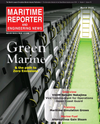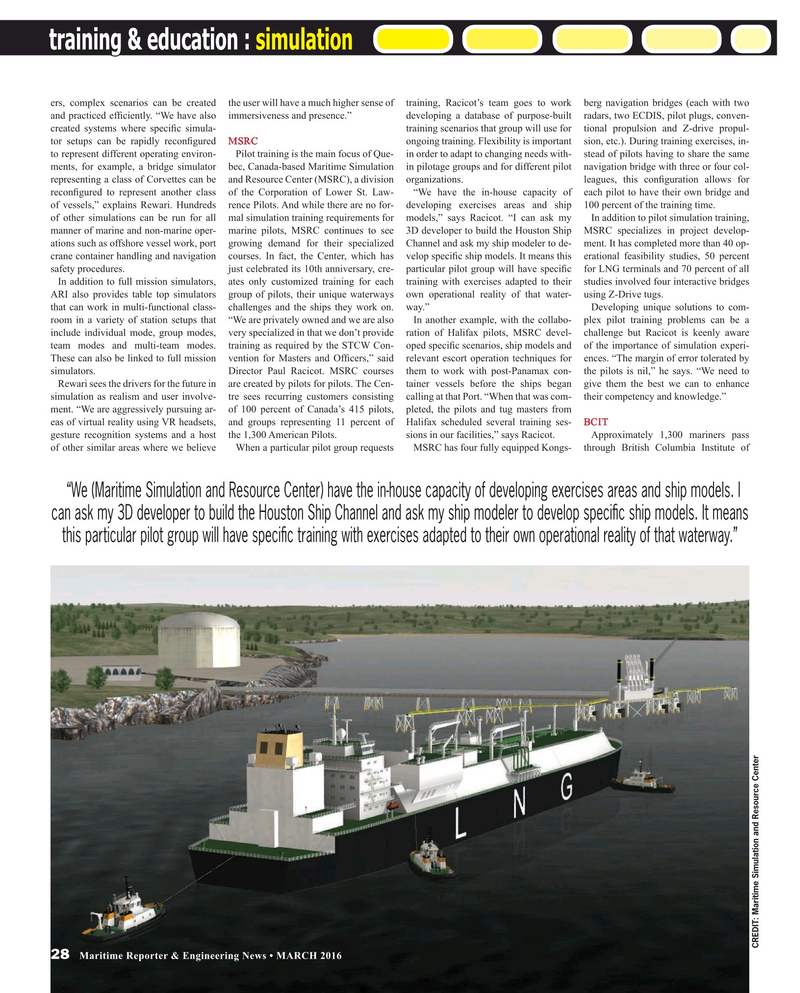
Page 28: of Maritime Reporter Magazine (March 2016)
Green Marine Technology
Read this page in Pdf, Flash or Html5 edition of March 2016 Maritime Reporter Magazine
training & education : simulation ers, complex scenarios can be created the user will have a much higher sense of training, Racicot’s team goes to work berg navigation bridges (each with two and practiced ef? ciently. “We have also immersiveness and presence.” developing a database of purpose-built radars, two ECDIS, pilot plugs, conven- created systems where speci? c simula- training scenarios that group will use for tional propulsion and Z-drive propul- tor setups can be rapidly recon? gured MSRC ongoing training. Flexibility is important sion, etc.). During training exercises, in- to represent different operating environ- Pilot training is the main focus of Que- in order to adapt to changing needs with- stead of pilots having to share the same ments, for example, a bridge simulator bec, Canada-based Maritime Simulation in pilotage groups and for different pilot navigation bridge with three or four col- representing a class of Corvettes can be and Resource Center (MSRC), a division organizations. leagues, this con? guration allows for recon? gured to represent another class of the Corporation of Lower St. Law- “We have the in-house capacity of each pilot to have their own bridge and of vessels,” explains Rewari. Hundreds rence Pilots. And while there are no for- developing exercises areas and ship 100 percent of the training time.
of other simulations can be run for all mal simulation training requirements for models,” says Racicot. “I can ask my In addition to pilot simulation training, manner of marine and non-marine oper- marine pilots, MSRC continues to see 3D developer to build the Houston Ship MSRC specializes in project develop- ations such as offshore vessel work, port growing demand for their specialized Channel and ask my ship modeler to de- ment. It has completed more than 40 op- crane container handling and navigation courses. In fact, the Center, which has velop speci? c ship models. It means this erational feasibility studies, 50 percent safety procedures. just celebrated its 10th anniversary, cre- particular pilot group will have speci? c for LNG terminals and 70 percent of all
In addition to full mission simulators, ates only customized training for each training with exercises adapted to their studies involved four interactive bridges
ARI also provides table top simulators group of pilots, their unique waterways own operational reality of that water- using Z-Drive tugs. that can work in multi-functional class- challenges and the ships they work on. way.” Developing unique solutions to com- room in a variety of station setups that “We are privately owned and we are also In another example, with the collabo- plex pilot training problems can be a include individual mode, group modes, very specialized in that we don’t provide ration of Halifax pilots, MSRC devel- challenge but Racicot is keenly aware team modes and multi-team modes. training as required by the STCW Con- oped speci? c scenarios, ship models and of the importance of simulation experi-
These can also be linked to full mission vention for Masters and Of? cers,” said relevant escort operation techniques for ences. “The margin of error tolerated by simulators. Director Paul Racicot. MSRC courses them to work with post-Panamax con- the pilots is nil,” he says. “We need to
Rewari sees the drivers for the future in are created by pilots for pilots. The Cen- tainer vessels before the ships began give them the best we can to enhance simulation as realism and user involve- tre sees recurring customers consisting calling at that Port. “When that was com- their competency and knowledge.” ment. “We are aggressively pursuing ar- of 100 percent of Canada’s 415 pilots, pleted, the pilots and tug masters from eas of virtual reality using VR headsets, and groups representing 11 percent of Halifax scheduled several training ses- BCIT gesture recognition systems and a host the 1,300 American Pilots. sions in our facilities,” says Racicot. Approximately 1,300 mariners pass of other similar areas where we believe When a particular pilot group requests MSRC has four fully equipped Kongs- through British Columbia Institute of “We (Maritime Simulation and Resource Center) have the in-house capacity of developing exercises areas and ship models. I can ask my 3D developer to build the Houston Ship Channel and ask my ship modeler to develop speci? c ship models. It means this particular pilot group will have speci? c training with exercises adapted to their own operational reality of that waterway.”
CREDIT: Maritime Simulation and Resource Center 28 Maritime Reporter & Engineering News • MARCH 2016
MR #3 (26-33).indd 28 3/2/2016 11:25:03 AM

 27
27

 29
29
